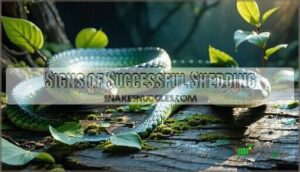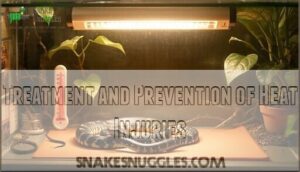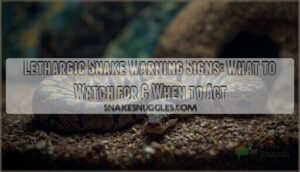This site is supported by our readers. We may earn a commission, at no cost to you, if you purchase through links.

You’ll encounter problems like stuck shed, mites, scale rot, and bacterial infections most often.
Poor humidity levels cause shedding problems, while dirty substrates lead to scale rot.
Mites spread quickly between snakes and require thorough habitat cleaning.
Early detection is key—check your snake weekly for unusual scales, swelling, or discharge.
Most issues stem from improper temperature, humidity, or cleanliness in their enclosure.
Simple environmental adjustments prevent many problems before they start.
Serious infections need veterinary treatment, but many conditions respond well to proper husbandry changes and basic first aid measures.
Table Of Contents
- Key Takeaways
- Common Snake Skin Problems
- Environmental Factors Affecting Snake Skin
- Recognizing and Treating Snake Skin Issues
- Prevention and Maintenance for Healthy Skin
- Specific Snake Skin Conditions
- Shedding and Skin Renewal
- Heat Injuries and Scale Rot
- Bacterial and Viral Infections
- Harlequin Ichthyosis and Skin Conditions
- Advanced Care and Solutions
- Frequently Asked Questions (FAQs)
- How to treat a skin infection on a snake?
- How to cure snake skin disease?
- What does a skin infection look like on a snake?
- How do you treat snakeskin?
- How do you treat a snake skin infection?
- How to get rid of snake skin?
- What solution for snake skin?
- How do you help your snake shed his skin?
- What are the signs of a stressed snakes skin problems?
- How do I identify snake skin problems in albino snakes?
- Conclusion
Key Takeaways
- Prevention beats treatment every time — you’ll save your snake from serious health issues by maintaining proper humidity (50-60%), using clean substrate, and controlling temperature gradients rather than dealing with infections later.
- Weekly inspections catch problems early — you should check for stuck shed, mites, scale discoloration, and lesions during routine handling since early detection prevents minor issues from becoming life-threatening conditions.
- Environmental factors cause most skin problems — you’ll prevent scale rot, bacterial infections, and shedding issues by keeping humidity controlled, substrate dry, and heating equipment properly regulated with thermostats.
- Don’t delay veterinary care for serious infections — you need professional treatment for bacterial abscesses, mouth rot, and systemic infections since antibiotics and proper diagnosis are essential for recovery.
Common Snake Skin Problems
You’ll encounter several common skin problems that can affect your snake’s health and comfort.
These issues range from bacterial infections like abscesses to parasitic infestations, but most are preventable with proper husbandry and early detection.
Abscesses and Their Causes
Infected cuts create perfect breeding grounds for bacterial abscesses in your snake’s skin.
These painful pus formation pockets develop when bacteria invade wounds from handling mishaps, rough substrate, or cage injuries.
Skin infections worsen without proper wound care, turning minor scrapes into serious bacterial abscess problems.
Watch for swelling, discoloration, and your snake’s reluctance to move normally.
Regular awareness of common snake diseases is essential for preventing such complications.
Blister Disease and Prevention
Blister disease thrives in dirty, overly moist environments that create perfect breeding grounds for harmful bacteria.
You’ll want to tackle these prevention methods head-on:
- Humidity control – Keep levels between 30-60% using a reliable hygrometer
- Safe substrate choice – Use aspen, cypress mulch, or reptile carpet instead of moldy materials
- Regular cleaning – Disinfect habitat weekly to prevent bacterial buildup and scale health issues
Bloating and Constipation
When your snake’s belly looks unusually swollen, constipation might be the culprit. This digestive issue stems from improper feeding schedules, inadequate water intake, or unsuitable substrates.
Dietary changes focusing on appropriate prey size and gut health can prevent intestinal blockages.
Warm water soaks help relieve bloating while proper hydration supports digestive function, reducing snake skin problems linked to poor overall health.
Parasites and Their Transmission
Unwanted guests can turn your snake’s habitat into a dangerous environment.
Parasites spread through multiple pathways that every snake owner must understand to protect their pet’s health.
Parasite Transmission occurs through these critical routes:
- Direct contact – Your snake picks up internal parasites like helminths and protozoa when exposed to infected feces or vomit from other reptiles.
- Contaminated food – Feeding infected prey items introduces parasites directly into your snake’s system, making food source quality essential.
- Infected water – Stagnant, dirty water harbors dangerous organisms that cause parasite life cycles to flourish in your snake’s environment.
- Poor habitat hygiene – Irregular cleaning creates perfect breeding conditions for snake skin parasites, leading to serious mite control challenges and tick removal needs.
Understanding parasite prevention starts with recognizing these transmission methods and implementing proper snake mites management protocols.
Mites and Ticks Identification
Mites and ticks show up as tiny moving dots on your snake’s skin.
Snake mites appear as red or black specks crawling around scales, while ticks look like small bumps attached to the skin.
Check areas where scales meet – around the eyes, heat pits, and under the chin.
Mite removal requires careful skin inspection using a magnifying glass.
External infestations need immediate parasite control through proper identification and targeted treatment.
Environmental Factors Affecting Snake Skin
Your snake’s environment directly impacts its skin health, with improper conditions leading to infections, shedding problems, and serious complications.
Creating the right habitat setup with proper temperature, humidity, substrate, and cleanliness prevents most skin issues before they start.
Habitat Setup for Optimal Health
Keeping your snake’s skin in top shape starts with the right setup.
Start your snake enclosure as you’d set up a high-end spa—because every client deserves comfort and safety.
Focus on these four:
- Guarantee temperature regulation with a gradient for natural Temperature Control.
- Practice effective Humidity Management.
- Choose an escape-proof Enclosure Design with solid ventilation.
- Provide enough space for healthy movement.
With consistent habitat hygiene, you’ll support healthy, stress-free scales.
Maintaining the right environment involves understanding temperature control systems to promote overall well-being.
Substrate Options for Snakes
Your snake’s foundation matters more than you might think. Poor substrate choices can spell disaster for your pet’s skin health, while the right bedding creates a protective barrier against infections.
Choosing the right snake bedding is vital, and researching proper snake bedding options can help prevent skin problems.
| Substrate Type | Benefits | Considerations |
|---|---|---|
| Aspen Substrate | Natural burrowing material, absorbs moisture well | Replace when soiled, monitor for mold |
| Reptile Carpet | Easy cleaning, prevents ingestion risks | Wash regularly, check for fraying edges |
| Cypress Mulch | Retains humidity, natural appearance | Avoid cedar varieties, dust-free options best |
| Paper Towels | Sterile, easy monitoring of waste | Less natural, requires frequent changes |
| Gravel Options | Good drainage, easy sanitization | Avoid sharp edges, make certain of proper sizing |
Choose snake bedding that won’t irritate sensitive skin or cause respiratory problems. Your substrate options directly impact reptile skin care success.
Maintaining Proper Humidity Levels
Your substrate choice sets the stage, but humidity control creates the perfect environment for healthy skin health.
Maintain 30-60% humidity using a hygrometer to monitor levels precisely.
This humidity management prevents respiratory disease and supports proper shedding.
Create a humid microclimate with water bowls or humidity havens using damp substrate areas.
Proper snake skin humidity control keeps your pet thriving.
Heating and Lighting Considerations
Perfect thermal burns prevention starts with proper heat sources and lighting systems.
Install ceramic heat emitters or under-tank heaters with thermostats for reliable temperature control.
Create basking spots at 88-92°F with cool zones at 78-80°F.
Monitor temperatures daily to avoid heat injuries.
Shield all heat source safety equipment from direct contact.
This temperature tango keeps your snake’s skin healthy while preventing dangerous thermal burns.
Bathing and Hydration for Snakes
Water bowls aren’t just decoration—they’re your snake’s spa treatment.
Proper hydration prevents skin problems and supports healthy shedding cycles.
- Use lukewarm water (100°F) for 10-15 minute soaks
- Choose shallow dishes to prevent drowning stress
- Schedule weekly baths during shedding periods
- Monitor water quality with dechlorinated, fresh water
Regular bathing techniques help with snake dehydration signs while maintaining ideal humidity control for snake skin health issues.
Recognizing and Treating Snake Skin Issues
Spotting skin problems early can mean the difference between a simple treatment and a serious health crisis for your snake.
Quick identification followed by proper veterinary care and targeted treatment will keep your scaly friend healthy and comfortable, ensuring a simple treatment is possible.
Early Detection of Skin Problems
Early detection acts as your first line of defense against serious snake skin problems.
Regular health checks help you spot trouble before it becomes life-threatening.
Skin inspection methods you should use:
- Visual cues: Check for lesions, swelling, discoloration, or unusual bumps during weekly examinations
- Early warning signs: Monitor appetite changes, lethargy, vomiting, or abnormal stool quality patterns
- Diagnostic tools: Watch for behavioral shifts like excessive hiding or loss of environmental interest
Veterinary Assessment and Diagnosis
When skin issues persist despite home care, your veterinarian becomes your snake’s lifeline.
A thorough clinical exam reveals what naked eyes miss—subtle swelling, discoloration, or diagnostic clues hiding beneath scales.
Veterinary care includes thorough diagnostic tests like skin cytology, culture sensitivity, and microscopic evaluation.
For stubborn lesions, your vet might recommend a skin biopsy using diagnostic tools and medical imaging to guide antibiotic therapy decisions.
Accurate diagnosis often relies on fungal disease testing to identify the underlying cause of skin problems.
Treatment Options for Skin Infections
Once your veterinarian confirms the diagnosis, you’ll have several treatment options at your disposal.
Antibiotic therapy targets bacterial snake skin infections effectively, while antifungal medications combat fungal issues.
Topical ointments provide direct application for localized problems, and wound care keeps affected areas clean and protected.
Advanced cases may benefit from laser treatment, which promotes faster healing and reduces scarring in severe infections.
Habitat Cleaning and Disinfection
After treatment, you can’t ignore the elephant in the room—your snake’s contaminated environment. Poor habitat hygiene breeds reinfection, making environmental disinfection your next priority.
Follow these sanitizing methods for complete decontamination:
- Remove all substrate and décor for thorough cleaning
- Apply reptile-safe disinfectants to eliminate bacteria and parasites
- Establish cleaning schedules with weekly spot-cleaning and monthly deep sanitization
- Replace substrate completely to prevent infected water sources
This systematic approach controls humidity while ensuring snake skin hygiene remains ideal.
Isolating The Snake for Recovery
Proper Recovery Tanks provide controlled healing environments that reduce stress during treatment.
Set up isolation chambers with stable temperatures and humidity levels to prevent secondary infections.
Snake quarantine periods typically last 2-4 weeks, giving your pet time to recover without competing for resources or facing territorial disputes that worsen snake skin problems, in a stable environment.
Prevention and Maintenance for Healthy Skin
Preventing snake skin problems starts with consistent care routines that catch issues before they become serious health threats.
You’ll protect your snake’s health through regular monitoring, proper nutrition, and proactive veterinary care that keeps skin conditions at bay.
Regular Inspections for Skin Issues
Conducting thorough skin checks helps you spot problems before they escalate.
Examine your snake weekly, looking for shedding issues like retained pieces, scale problems including discoloration or blisters, eye infections with cloudiness, and tail lesions or swelling.
Focus on areas where snake skin problems commonly develop – around the vent, neck folds, and belly scales.
Proper lighting makes spotting snake skin conditions easier during these essential health assessments.
Providing a Balanced Diet for Snakes
Your snake’s skin health starts with nutrient balance. Whole prey like mice and rats provide complete nutrition, including calcium, vitamins, and protein essential for healthy shedding.
- Feeding Schedule: Young snakes eat twice weekly; adults every 10-14 days
- Prey Variety: Rotate between mice and rats for broader nutritional profiles
- Dietary Supplements: Rarely needed with whole prey, but consult your vet for special cases
Proper snake nutrition prevents calcium and vitamin deficiencies that cause snake skin issues and shedding problems. A well-planned healthy snake diet is vital for maintaining healthy skin health in snakes.
Safe Prey Options for Snakes
Smart choices at feeding time directly impact your snake’s skin health. The foundation begins with understanding your pet’s specific dietary needs.
Consider these essential factors when selecting prey:
- Prey Size: Choose items roughly the same width as your snake’s thickest body section to prevent regurgitation and stress
- Feeding Techniques: Frozen thawed options eliminate injury risks while live food may cause defensive bites and scratches
- Prey Variety: Rotate between mice, rats, and appropriate alternatives to guarantee complete nutritional profiles
- Prey Sources: Purchase from reputable suppliers who maintain proper hygiene standards and disease-free breeding colonies
Proper prey frequency prevents digestive issues that can manifest as skin problems, while balanced nutrition supports natural shedding cycles and immune function.
Preventative Care and Veterinary Checkups
Why wait until problems appear when regular checkups catch issues early?
Schedule veterinary visits every 6-12 months for preventative care and health monitoring. These appointments include physical exams, fecal testing, and blood work that prevent snake skin problems before they start.
Your vet provides disease prevention strategies, veterinary guidance, and preventative measures suited to your snake’s needs. Early veterinary treatment costs less than emergency care.
Preventative Care Why It Matters What to Expect
Specific Snake Skin Conditions
Understanding specific snake skin conditions helps you recognize serious health threats early. These conditions require immediate veterinary attention and targeted treatment protocols to prevent complications.
Infectious Stomatitis (Mouth Rot)
Beyond poor husbandry, infectious stomatitis strikes when opportunistic bacteria invade through mouth trauma.
You’ll spot pinpoint hemorrhages, swelling, and excess saliva early on.
Advanced cases show cheese-like pus, inflamed tissues, and potential tooth loss.
Left untreated, mouth rot spreads systemically, causing pneumonia or septicemia.
Treatment requires thorough cleaning, antibiotic therapy, and immediate husbandry corrections for recovery.
Internal and External Parasites
Parasites wreak havoc on your snake’s health through multiple transmission routes. These unwelcome guests spread via contaminated food, infected water, direct contact, and poor habitat hygiene, making prevention your strongest defense.
Prevention beats treatment every time—keep parasites out before they move in.
- Mite Control: Monitor for red or black spots crawling on your snake’s skin
- Tick Removal: Check scales regularly for embedded parasites, especially around head and neck areas
- Internal Parasites: Watch for weight loss, regurgitation, and abnormal stool consistency
- Parasite Transmission: Quarantine new snakes and disinfect all equipment between animals
- Snake Mites: Look for white flecks (mite feces) in water bowls and hiding spots
Skin Infections (Dermatitis)
Dermatitis strikes when bacteria invade your snake’s compromised skin, often triggered by dirty environments, poor humidity, or mite infestations.
Bacterial dermatitis appears as red, swollen lesions that can quickly escalate into painful abscesses.
Fungal infections create similar skin lesions but with distinct crusty textures.
Monitor for infection control by maintaining pristine habitats and proper humidity levels to prevent these snake skin diseases.
Respiratory Disease and Infections
Respiratory diseases threaten your snake’s breathing and overall health. Poor air quality, inadequate ventilation, and bacterial infections commonly trigger these conditions.
Watch for mouth breathing, wheezing, or discharge from nostrils.
- Monitor breathing patterns – Normal snakes breathe quietly through their nostrils
- Maintain proper humidity levels – 50-60% prevents respiratory stress and infections
- Ensure adequate ventilation – Fresh airflow reduces bacterial buildup in enclosures
- Schedule veterinary care – Early antibiotic treatment prevents progression to septicemia
Septicemia and Viral Diseases
While respiratory infections pose serious threats, septicemia and viral diseases represent snake health emergencies that demand immediate action.
Septicemia occurs when bacteria enter your snake’s bloodstream, creating systemic infection throughout the body. This condition often follows untreated wounds or compromised immune systems.
Viral diseases like reptarenavirus, iridovirus, and adenovirus spread through direct contact and contaminated surfaces. These pathogens manipulate viral loads within infected snakes, potentially triggering septic shock if left untreated.
Key management strategies include:
- Infection control: Quarantine infected snakes and disinfect all equipment thoroughly
- Disease transmission prevention: Isolate new arrivals and practice strict hygiene protocols
- Immune response support: Maintain ideal temperatures and reduce environmental stressors
- Immediate veterinary care: Blood work and aggressive antibiotic therapy prevent systemic collapse
Early intervention substantially improves survival rates for both conditions.
Shedding and Skin Renewal
Understanding your snake’s shedding cycle is vital for maintaining healthy skin and preventing complications.
You’ll need to recognize normal shedding patterns and know when to step in with assistance to guarantee your pet sheds completely and safely, ensuring a healthy environment.
Normal Shedding Process in Snakes
Understanding your snake’s shedding process helps you provide better care during this natural cycle.
Healthy snakes typically shed every 4-6 weeks, though younger snakes molt more frequently due to rapid growth.
The shedding cycle begins when your snake’s skin becomes dull and eyes turn milky blue.
This skin renewal process allows for continued growth while removing parasites and damaged scales.
During snake molting, your pet may refuse food and seek rough surfaces for rubbing.
The entire shedding process usually takes 7-14 days from start to finish.
Shedding Problems and Causes
When humidity drops below 50%, your snake’s dysecdysis becomes likely.
Poor temperature control, lack of rough surfaces, and nutritional deficiencies create perfect conditions for stuck shed. Stress from handling during shedding cycles worsens skin retention problems.
Dysecdysis Causes include:
- Humidity Control failures – Levels below 50-70% cause shedding problems
- Temperature issues – Inconsistent warmth around 80-85°F complicates snake skin shedding
- Environmental factors – Missing rough surfaces prevent natural shed removal
- Health conditions – Parasites, infections, and malnutrition trigger shedding disorders
Assisting Your Snake With Shedding
When your snake faces shedding woes, you’re their best ally.
Boost humidity control to 60-80% during the shedding cycle. Provide shallow warm water soaks for stubborn dysecdysis.
Gently rub retained skin with damp cloth, working from head to tail. Add rough surfaces like branches for natural skin removal.
These shedding solutions support essential snake hydration and skin health throughout the snake shedding process. Maintaining proper humidity levels is vital, and using a humidifier device can help achieve this.
Signs of Successful Shedding
A successful shed reveals itself through unmistakable signs.
You’ll see smooth, vibrant new skin with healthy scales that gleam under light. The eyes become crystal clear after being cloudy, and no old skin remains on the tail or body.
This skin renewal process typically spans 7-14 days from start to finish.
Post shed care involves checking for any retained pieces and ensuring your snake’s environment supports continued shedding solutions for future cycles.
Heat Injuries and Scale Rot
Heat injuries represent one of the most preventable yet serious threats to your snake’s health, often resulting from improper heating equipment or inadequate thermal regulation in their enclosure.
Scale rot, a bacterial infection that thrives in overly moist conditions, can quickly escalate from minor skin irritation to life-threatening systemic infection if left untreated, and is a serious threat due to improper heating and inadequate thermal regulation.
Causes of Heat Injuries in Snakes
Heat injuries pose serious threats when Heat Sources create dangerous thermal zones in Snake Enclosures.
Poor Temperature Control and unshielded Heating Elements cause Thermal Burns through direct contact.
Common causes include:
- Malfunctioning heat mats without thermostats creating hotspots
- Unguarded ceramic heaters or basking bulbs allowing direct contact
- Inadequate temperature monitoring leading to overheated surfaces
Proper heat injuries prevention requires thermostat-controlled equipment and regular temperature checks.
Symptoms of Scale Rot
Recognizing scale rot early can save your snake’s life.
Blisters, skin lesions, and discolored patches signal trouble—especially when accompanied by ulcerative dermatitis or foul-smelling discharge.
Watch for blister disease spreading across belly scales, creating raised, fluid-filled bumps.
Dermatitis appears as red, inflamed areas that worsen without treatment.
Snake skin problems like scale rot often start small but spread rapidly, making early detection essential for successful intervention.
Understanding scale rot causes is key to preventing the condition from worsening.
Treatment and Prevention of Heat Injuries
Burns demand immediate attention—cool running water for 15-20 minutes prevents deeper tissue damage, while avoiding ice that worsens injuries.
Essential heat injury protocols:
- Emergency cooling: Apply cold compress or running water immediately, never ice directly on burns
- Wound protection: Move snake to substrate-free enclosure, clean gently with diluted antiseptics
- Prevention setup: Install thermostat-controlled heating, eliminate hot rocks, maintain proper thermal gradient
Severe burns require veterinary fluid therapy and systemic antibiotics. Monitor all heat sources regularly—equipment malfunction causes most thermal burns in captive snakes.
Prevention of Scale Rot
Prevention of Scale Rot means keeping humidity control between 30-50% using proper hydration methods. Clean substrate like aspen prevents bacterial growth that causes snake skin problems.
Here’s your action plan:
- Monitor skin monitoring weekly for early scale rot detection
- Replace substrate immediately when soiled to prevent reptile skin diseases
- Make certain scale care through proper ventilation and dry surfaces
Bacterial and Viral Infections
Bacterial and viral infections pose serious health risks to your snake and require prompt veterinary intervention to prevent complications or death.
You’ll need to recognize early symptoms like skin discoloration, lethargy, and appetite loss to guarantee successful treatment outcomes, which is crucial for the snake’s health and requires prompt action.
Common Bacterial Infections in Snakes
Bacterial abscesses form when cuts become infected, creating painful pus pockets beneath your snake’s scales.
Mouth rot represents the most serious bacterial threat, requiring immediate antibiotic intervention.
Snake dermatitis develops from dirty environments, while scale rot emerges from excess moisture and contaminated bedding.
Skin lesions appear as discolored patches or blisters.
Effective infection control demands proper habitat hygiene and prompt veterinary treatment when bacterial infections strike.
Viral Infections and Their Transmission
While bacterial infections pose serious threats, viral diseases present unique challenges for snake owners.
Unlike bacteria, viruses can’t be treated with antibiotics and often spread silently through your collection.
Major viral threats include:
- Inclusion Body Disease (IBD) – Fatal reptarenavirus causing neurological symptoms in pythons
- Nidovirus – Respiratory infection spreading rapidly through snake mites and airborne droplets
- Paramyxovirus – Highly contagious among vipers, attacking respiratory and nervous systems
Viral transmission occurs through direct contact, contaminated equipment, and infected mites.
Vertical transmission from parent to offspring makes breeding decisions critical for infection control.
Treatment Options for Bacterial Infections
When bacterial infections strike, you’ll need a thorough treatment approach.
Antibiotic therapy forms the backbone of treatment, while topical treatments address localized skin infections directly.
- Antibiotic therapy: Veterinarian-prescribed medications target specific bacterial strains
- Topical creams: Applied directly to infected areas for localized treatment
- Wound care: Daily cleaning and disinfection of affected skin areas
- Bacterial tests: Laboratory analysis identifies specific infection types for targeted treatment
- Laser treatment: Advanced therapy option for stubborn or recurring infections
- Infection prevention: Environmental modifications to prevent recontamination during healing
Prevention of Viral Infections
While bacterial infections can be treated, viral diseases require different preventative care strategies.
You’ll need strong quarantine protocols to isolate new arrivals for 30-60 days.
Environmental disinfection using diluted bleach solutions helps eliminate viral particles from surfaces.
Maintain proper humidity control and skin hygiene through regular habitat cleaning.
Vaccination options are limited for reptiles, so focus on immune boost through proper nutrition and stress reduction.
Prevention Method Description
Harlequin Ichthyosis and Skin Conditions
While most snake skin conditions are manageable with proper care, ichthyosis represents one of the more complex dermatological challenges you might encounter in reptile husbandry.
This rare genetic condition affects scale formation and requires specialized treatment approaches that differ substantially from common skin problems like scale rot or bacterial infections.
What is Harlequin Ichthyosis?
Harlequin ichthyosis represents the most severe form of congenital skin defects, affecting approximately one in 300,000 newborns worldwide.
This devastating genetic disorder results from ABCA12 gene mutations that disrupt normal skin barrier formation.
Affected infants are born encased in thick, armor-like scales that severely restrict movement and breathing.
- Ichthyosis inheritance patterns follow autosomal recessive genetics requiring carrier parents
- Harlequin symptoms include diamond-shaped skin plates separated by deep, painful fissures
- Dermatological research focuses on lipid transport defects causing abnormal keratinization processes
- Reptile skin disorders share similar scaling patterns but differ in underlying genetic mechanisms
Causes and Symptoms of Ichthyosis
Several factors contribute to ichthyosis causes in snakes, creating challenging scaly skin conditions.
Genetic mutations affect normal skin development, leading to congenital skin defects. Environmental stressors worsen scale issues, while poor husbandry triggers skin infections.
You’ll notice thick, flaky patches and shedding problems as primary symptoms.
Ichthyosis Factors Description
Treatment and Management of Ichthyosis
Treatment breakthroughs offer hope for managing ichthyosis in snakes.
You’ll need proper diagnosis through skin scrapings before starting moisturizing treatments or topical therapies.
Genetic factors determine treatment options, while filaggrin gene therapy shows promise for severe cases.
- Skin scaling patterns revealing underlying genetic mutations
- Laboratory tests confirming ichthyosis vulgaris types through microscopic examination
- Gentle moisturizing treatments penetrating damaged skin barriers effectively
- Topical applications creating protective layers over affected scales
- Support networks connecting owners facing similar harlequin symptoms challenges
The use of moisturizing treatments is crucial in managing the condition.
Other Skin Conditions in Snakes
Beyond ichthyosis, you’ll encounter dysecdysis (incomplete shedding), scale rot from excess moisture, thermal burns from improper heating, and fungal diseases like Ophidiomyces.
These conditions include dermatitis, which creates painful skin lesions, while blister disease thrives in dirty environments.
These snake skin conditions respond well to proper humidity control, substrate selection, and veterinary care when caught early.
Advanced Care and Solutions
When standard treatments aren’t enough, advanced veterinary care offers specialized solutions for complex snake skin conditions.
These cutting-edge approaches include laser therapy, surgical grafts, and emerging experimental treatments that can save your snake’s life.
Advanced Treatment Options for Skin Issues
When standard treatments fall short, veterinary dermatology offers breakthrough solutions for complex snake skin conditions:
- Laser Therapy: Low-level laser therapy accelerates wound care by stimulating cellular repair and reducing inflammation in damaged tissue.
- Skin Grafts: Advanced surgical techniques transplant healthy scales to restore severely compromised areas, promoting natural skin regeneration.
- Gene Editing: Experimental antimicrobial peptides and targeted therapies address genetic skin disorders through precise molecular interventions.
Surgical Interventions for Skin Problems
Advanced treatments sometimes fall short when skin damage runs deep.
When your snake faces severe tissue damage, surgical interventions offer powerful solutions. Laser therapy precisely targets infected areas while promoting faster healing. Skin grafts replace damaged tissue with healthy alternatives. Surgical debridement removes dead tissue, preventing further infection spread. Reconstructive surgery restores function and appearance. Wound closure techniques guarantee proper healing. Cryotherapy freezes problematic tissue away cleanly.
Surgical Intervention Description Benefits
Experimental Treatments for Snake Skin Conditions
When traditional medicine falls short, cutting-edge therapies offer new hope for your snake’s stubborn skin conditions.
These innovative approaches target problems at the cellular level:
- Gene editing techniques modify DNA to correct genetic skin defects and boost natural healing responses
- Stem cell therapy regenerates damaged tissue by injecting healthy cells that transform into new skin layers
- Nanotechnology applications deliver targeted medications through microscopic particles that penetrate infected areas more effectively
Future Research and Developments in Snake Skin Care
New research is transforming snake care through genetic research and biomedical advances. Scientists are developing personalized treatment plans using gene editing to strengthen skin barriers.
Nanotechnology applications deliver targeted medications, while stem cell therapy promotes skin regeneration. Biomimicry helps understand natural healing processes.
- Your snake could benefit from treatments customized to their specific genetic makeup
- Revolutionary therapies might prevent skin problems before they start
- Advanced care could extend your pet’s lifespan substantially
Frequently Asked Questions (FAQs)
How to treat a skin infection on a snake?
Many think topical treatments alone cure skin infections, but you’ll need veterinary diagnosis first.
Clean the habitat immediately, isolate your snake, and apply prescribed antibiotics or antifungals while maintaining proper humidity levels, which is crucial for the snake’s recovery and proper humidity.
How to cure snake skin disease?
You’ll need veterinary diagnosis first – skin diseases require specific treatments like antibiotics for bacterial infections, antifungals for fungal issues, or antiparasitic medications for mites. Improve habitat conditions immediately.
What does a skin infection look like on a snake?
Seeing red, swollen patches with blisters signals trouble.
You’ll notice discolored scales, ulcers, or lesions on your snake’s belly or sides.
Bacterial infections create painful, pus-filled areas that worsen without treatment, which can be a sign of trouble.
How do you treat snakeskin?
Treating snake skin infections requires veterinary diagnosis first. Clean the habitat thoroughly, maintain proper humidity (50-60%), and apply prescribed topical antibiotics or antifungals as directed by your reptile veterinarian.
How do you treat a snake skin infection?
Treat snake skin infections with topical antibiotics and antifungal medications prescribed by a veterinarian.
Clean the habitat thoroughly, maintain proper humidity levels, and isolate your snake during recovery to prevent spread, using topical antibiotics and following the veterinarian’s advice to ensure a smooth recovery.
How to get rid of snake skin?
Contrary to popular belief, you can’t just peel away snake presence like unwanted wallpaper.
Remove shed skins immediately using gloves, disinfect the area thoroughly, and inspect for living snakes nearby that may still be shedding, which involves complete concepts like removing shed skins.
What solution for snake skin?
You’ll need proper humidity (50-60%), clean substrate, and veterinary treatment for infections. Address underlying causes like poor habitat conditions, parasites, or injuries promptly to prevent complications.
How do you help your snake shed his skin?
Jake’s ball python struggled with stuck eyecaps for weeks until he increased humidity to 60% and provided warm soaks.
You’ll help your snake shed by maintaining proper humidity levels, offering shallow warm water baths, and ensuring rough surfaces for rubbing assistance during shedding cycles.
What are the signs of a stressed snakes skin problems?
Stressed snakes show scale rot, retained shed patches, dull coloration, excessive hiding, poor appetite, and visible skin lesions.
You’ll notice respiratory issues, mouth rot, or unusual behaviors alongside these dermatological symptoms, which can include visible skin lesions.
How do I identify snake skin problems in albino snakes?
Investigating albino snake theory reveals their pale pigmentation doesn’t hide skin problems—it actually makes issues more visible.
You’ll spot scale discoloration, retained sheds, mites, and lesions easier against their light background than darker snakes, which is a key aspect of their pale pigmentation.
Conclusion
Preventing snake skin problems and solutions starts with your commitment to proper husbandry—it’s the foundation of reptile health.
You’ve learned that temperature, humidity, and cleanliness directly impact your snake’s skin condition.
Regular inspections catch issues early, while proper substrate and heating prevent scale rot and thermal burns.
When problems arise, don’t delay veterinary care for serious infections.
Simple environmental adjustments resolve most conditions, but bacterial infections require professional treatment.
Your snake’s health depends on consistent care and quick response to skin changes.
- https://www.petful.com/pet-health/snake-skin-problems/
- https://lbah.com/reptile/snake-skin-conditions/
- https://www.fws.gov/question-answer/understanding-snake-fungal-disease-impacts-treatments-and-prevention
- https://www.nature.com/articles/s41598-024-55354-5
- https://www.merckvetmanual.com/all-other-pets/reptiles/disorders-and-diseases-of-reptiles





















